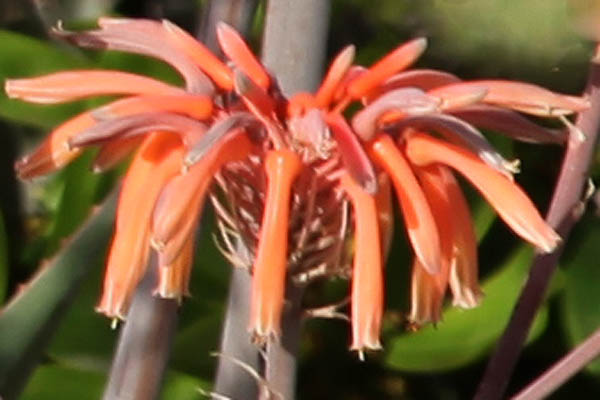Broadleaf aloe, Soap Aloe, Zebra Aloe, African Aloe,
אלוי סבוני
| Scientific name: | Aloe maculata All. | |
| Synonym name: | Aloe saponaria (Aiton) Haw., Aloe latifolia Haw., Aloe leptophylla N.E.Brown | |
| Common name: | Broadleaf aloe, Soap Aloe, Zebra Aloe or African Aloe | |
| Hebrew name: | אלוי סבוני | |
| Family: | Xanthorrhoeaceae → Asphodeloideae → Aloaceae |

Location: Western Galilee, Ness Amim guesthouse |
| Life form: | Chameophyte, Subshrubs | |
| Stems: | Stemless or with short stem | |
| Leaves: | Rosette with lance-shaped leaves that are thick and succulent, armed on the margin by sharp, dark-brown teeth, and pale green with white blotches or spots | |
| Inflorescence: | 40-100 cm, 3-8 branches, racemes capitate | |
| Flowers: | Red, orange, or yellow flowers; tubular perianth with a pronounced constriction above a bulbous basal swelling | |
| Fruits / pods: | Triangular capsule containing numerous seeds | |
| Flowering Period: | Spring through early summer | |
| Habitat: | Best with some shade | |
| Distribution: | Mediterranean Woodlands and Shrublands | |
| Chorotype: | Africa | |
| Summer shedding: | Perennating |

Location: Western Galilee, Ness Amim guesthouse Derivation of the botanical name: Aloe, from the Greek alsos and refers to the bitter juice from the leaves. This name probably derives either from the Arabic alloeh or the Hebrew allal, both meaning 'bitter.' maculata, maculo, to spot, stain, pollute, defile; spotted (spots are also influenced by the environment). saponaria, Latin sapo, soap; soapy. latifolia, latus,"broad", and folius, "leaf"; hence, "broad leaf" leptophylla, leptos, thin, slender, delicate, narrow, and folius, "leaf"; "slender leaf"

Location: Western Galilee, Ness Amim guesthouse |